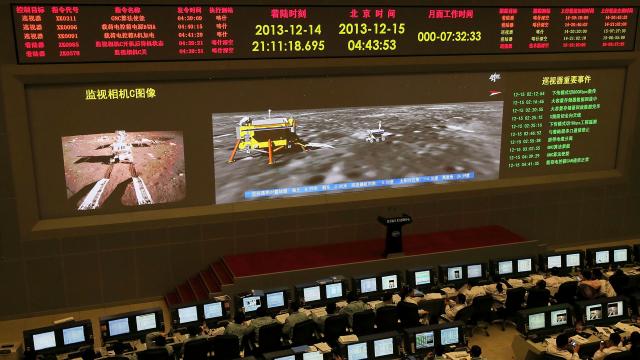The China National Space Administration (CNSA) has landed the Chang’e 4 lunar probe on the far side of the Moon, Chinese media reported on Wednesday night (Eastern Time)—marking the first time that any known spacecraft has made a soft landing on the Moon’s more distant half.
According to the Xinhua News Agency (a state media network), the Chang’e 4 probe launched from Xichang Satellite Launch Center in Sichuan Province on a Long March-3B carrier rocket on Dec. 8, 2018, and has orbited the Moon since Dec. 12. It delivered both a lander and a rover, while its Queqiao (Magpie Bridge) relay satellite “is operating in the halo orbit around the second Lagrangian (L2) point of the Earth-Moon system,” Xinhua added.
The state-owned CGTN network posted a photo it said was the f”world’s first close shot of [the] moon’s far side” on Twitter.
#China‘s Chang’e-4 probe sends back world’s first close shot of moon’s far side after historic soft landing on uncharted area https://t.co/OckokVjnh8 pic.twitter.com/ReORkkPcq3
— CGTN (@CGTNOfficial) January 3, 2019
#BREAKING: China’s Chang’e-4 probe successfully made the first-ever soft landing on the far side of the Moon on the South Pole-Aitken basin Thursday morning, a major milestone in space exploration. #ChangE4 pic.twitter.com/mt2YTWqlxs
— Global Times (@globaltimesnews) January 3, 2019
China’s Chang’e-4 probe touches down on the far side of the moon, becoming the first spacecraft soft-landing on the moon’s uncharted side never visible from Earth https://t.co/JoR13R5BUl pic.twitter.com/bS7fS4xwUt
— China Xinhua News (@XHNews) January 3, 2019
There appears to have been some earlier confusion about whether the landing actually occurred, as the state-run China Daily and CGTN deleted tweets celebrating the accomplishment earlier this evening. However, other Chinese media including the state-run China Central Television and the Communist Party of China-owned Global Times later confirmed Chang’e 4 had touched down on the lunar surface, per the Guardian.
The Moon is locked such that its orbit around the Earth is synchronised with its rotational speed—meaning that the far side is always pointing away from the planet. Contrary to its popular nickname, the far side of the Moon is not dark, and receives as much sunlight as its Earth-facing side. According to National Geographic, though CNSA is secretive, previous reports indicated it was targeting the Von Kármán crater located in the Moon’s South Pole-Aitken basin, the latter of which is “a low-lying feature more than 2,414km across that covers nearly a quarter of the Moon’s surface,” in addition to one of the largest known impact craters in the Solar System.
Priorities for the craft and its Earth-based control team include experiments on lunar low-frequency radio, low-gravity plant growth, and the relationship between solar winds and the Moon’s surface, as well as to determine “whether there is water or other resources at the poles,” according to CNN. Signals cannot pass through the Moon to the landing site, meaning the relay satellite is the only communication method—though this makes it ideal for a number of interesting experiments and may pave the way for future Chinese missions, CNN wrote:
“Since the far side of the moon is shielded from electromagnetic interference from the Earth, it’s an ideal place to research the space environment and solar bursts, and the probe can ‘listen’ to the deeper reaches of the cosmos,” said Tongjie Liu, deputy director of the Lunar Exploration and Space Program Center for the China National Space Administration.
… “It is highly likely that with the success of Chang’e — and the concurrent success of the human spaceflight Shenzhou program — the two programs will eventually be combined toward a Chinese human spaceflight program to the Moon,” [U.S. Naval War College professor Joan Johnson-Freese] added. “Odds of the next voice transmission from the Moon being in Mandarin are high.”
As CNN noted, the Chinese space program’s last lander, Yutu (Jade Rabbit), went out of operation in 2016 after making history as the first spacecraft from a nation other than the U.S. or Russia to make a lunar landing. (Other artificial objects have crash-landed on the Moon, such as defunct orbiters.)
The chief designer of China’s lunar probe program, Wu Weiren, said that mission provided valuable insights for the design of Chang’e 4, according to CNN. Several of the instruments aboard Chang’e 4 were previously used in the Yutu lander.
“It’s really a historic time, and I am very very excited!” China University of Geosciences planetary geoscientist Long Xiao wrote in an email to National Geographic. “With the successful landing and taking pictures by both the lander and rover soon, I am looking forward to see the real face of the far side!”
